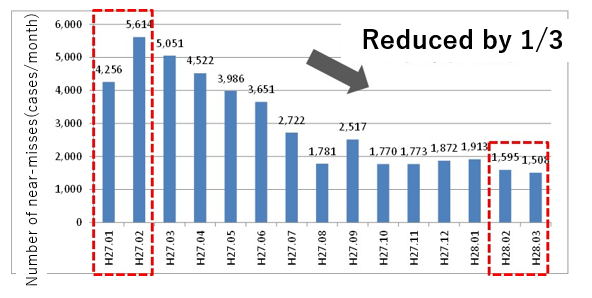Background/reasons for this initiative.
In 2013, there were 1,390 traffic accidents in Kashiwa City (about four accidents a day), resulting in the loss of five precious lives. Nationally, since April 2012, there have been a series of fatal accidents in which vehicles have ploughed into lines of children and other pedestrians on their way to and from primary schools, and the reduction of traffic accidents is a wish of local residents.
Oriental Consultants Co., Ltd, a member of the Kashiwa ITS Promotion Council, proposed the Kashiwa Traffic Safety Project, which uses drive recorder data to provide safe driving support services to drivers and to cooperate with the administration on traffic safety projects.
Kashiwa City Hall has around 510 official vehicles (excluding those under the jurisdiction of the Water Department). The city has had about 60 traffic accidents (most of them involving property damage) in the past three years, and as there is an urgent need to reduce the number of accidents, the proposal was accepted.
Period of implementation of the initiative.
November 2014 – March 2016
Description of initiatives
Three approaches were used to address the two main objectives of reducing accidents involving official vehicles and reducing traffic accidents in the Kashiwa city area.
Specifically, a target was set to halve the number of accidents involving vehicles with drive recorders installed. 200 vehicles were selected, mainly official vehicles with high accident rates (targeting passenger cars, ambulances, fire engines, refuse collection vehicles, etc.), and safe driving guidance was provided according to driver characteristics based on data obtained from driving. A workshop was also held for the official vehicle managers who actually provide this safe driving guidance.
The system also creates near-miss maps based on position data, image data, acceleration data, etc., and shares this information with the public to improve road facilities and reduce accidents.
Expected effects
The scale of the project, with 200 vehicles, which is approximately 41% of the official fleet and 54% of the accident rate, and the fact that the demonstration period is approximately one and a half years, which means that the project will be carried out continuously for a certain period of time, and that appropriate safe driving guidance can be provided for specific high-risk events based on data, are expected to significantly reduce the number of accidents. The data also allows for the implementation of appropriate safe driving guidance on specific high-risk events.
In addition, by sharing the Hiyari-Hatto maps with local residents and schools, it is expected that measures can be taken to reduce traffic accidents in accordance with the characteristics of the local area.
Status of initiatives
[Phase 1] Implementation of training sessions using drive recorder footage
- Conducted workshops using the footage collected by the drive recorder (held four times), with the aim of providing instructors (supervisors) with training on instruction methods and raising staff awareness of safe driving.
- The number of near-misses in official vehicles reduced by 1/3 since the project started.
[Phase 2] Implementation of road improvement measures using drive recorder data
- Based on the drive recorders installed in official vehicles, the locations of frequent near-misses were identified.
- Pruning (partial felling) of trees at the intersection in front of the library, where near-misses were occurring due to the same factor (poor visibility due to the influence of trees at the intersection).







